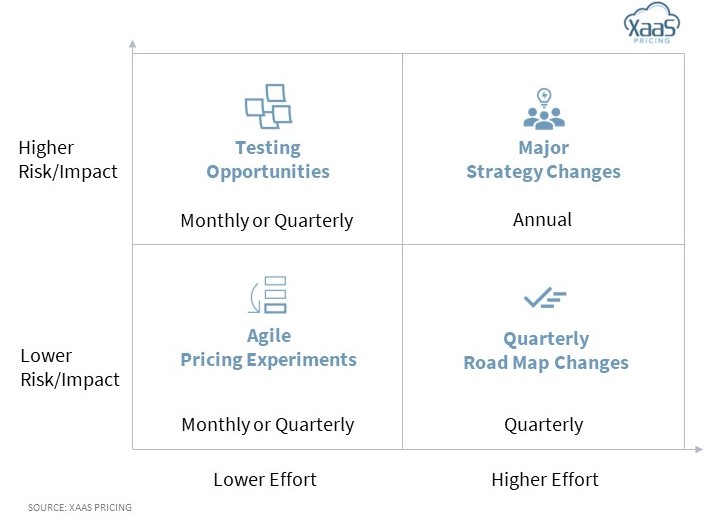In the roughly five months since our initial collection, 70 of the approximately 320 companies in the database have made changes to their packaging models, pricing models, and/or price and discounting levels
May 2022
Author: Bryan Belanger
May 2022
Author: Bryan Belanger

We began collecting XaaS Pricing data in mid-fall 2021, with the inaugural dataset completed and published on Nov. 1, 2021. In the roughly five months since that initial collection, 70 of the approximately 320 companies in the database have made changes to their packaging models, pricing models, and/or price and discounting levels.
We’ve tracked nearly 30 different types of changes, covering all aspects of packaging strategy, pricing models strategy, and pricing and discounting. The most common adjustment vendors made was to change actual price points. Nearly 50 of the 70 companies we cover made a change that involved adjusting their price points. Another common change was to adjust product packaging, typically by rebranding, adding or removing (most common) a product edition. Many vendors made this change in concert with updates to price points.
Only two of the 70 companies that made pricing changes had more than one instance of change over the five months we’ve been tracking the data. This suggests that most vendors are implementing pricing strategy changes quarterly or annually, or somewhere in between. Reasons for this include the methods and cadence in which customer and/or competitive research data is collected and analyzed, bandwidth and resources of the pricing team, decision-making and budgeting cycles, and technical systems considerations.
While there are many interesting case studies of pricing and packaging changes to dissect from the XaaS Pricing data, we curated three that we thought were particularly interesting, based on the magnitude of the changes made and the potential downstream customer impact.
If you’re interested in tracking pricing changes like these for your market category, specific competitors, and/or aspirational proxy vendors, XaaS Pricing can help. We’re capturing, indexing and archiving our data weekly and in real time based on vendor changes, enabling clients to view past and historical data side by side for a given company or companies.
Another indispensable tool in your pricing change analysis arsenal should be Wayback Machine. Once you’ve identified a change that a peer has made, you can search for their pricing website for specific dates and access the archived version of their pricing page for side-by-side analysis.
There is plenty of really high-value content out there that breaks down exactly how to approach making a change to price levels and how frequently you should do so. ProfitWell’s guide is a great primer on the best tactics for executing a pricing change.
There are also many really strong case studies available about vendors that went through pricing changes. A few examples include this one from GitLab and one from Noko Time Tracking for the Stacking the Bricks blog.
Together, the above resources and others like them provide a solid foundational framework for how to execute a pricing change. What we’re more interested in assessing at XaaS Pricing is the part that comes before — when you actually have to figure out what type of pricing change you’re going to make and why.
There’s plenty of general guidance available on the internet on the types of pricing changes you can make. Most articles focus primarily on a single type of pricing change: annual price increases. This is helpful general wisdom, as financial and operational performance benchmarks support the guidance that SaaS companies should consistently charge more and raise prices regularly.
However, a price increase is only one type of change, though it’s a fairly major change with high-impact customer ramifications. But as we noted above, we’ve observed 30 different types of changes in the XaaS Pricing companies we currently track. Pricing increases are one really important angle, but there are many angles with which vendors can experiment with changes. There are options to tweak price-related messaging and positioning on a more frequent and iterative basis, which can be a jumping off point for a more formal approach to pricing changes for companies getting started with more agile price strategies.
We break down the types of pricing changes a vendor can make into four categories, based on a simple quadrant of the effort it takes to make the change versus the potential risk and impact of the change.

The categories of pricing changes we define include:
If you’re interested in unpacking pricing changes in greater detail through the lens of XaaS Pricing’s data, subscribe to stay updated and we’ll automatically send you our next pulse report, publishing in May, which will focus on pricing changes observed since XaaS Pricing’s launch.
 ©2022 XaaS Pricing. All rights reserved. Terms of Service | Website Maintained by Tidal Media Group
©2022 XaaS Pricing. All rights reserved. Terms of Service | Website Maintained by Tidal Media Group

 Should we offer a lifetime deal for our SaaS product?
Should we offer a lifetime deal for our SaaS product?